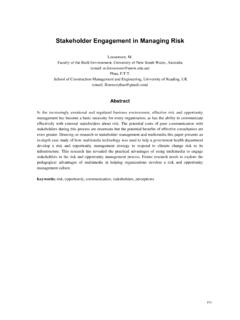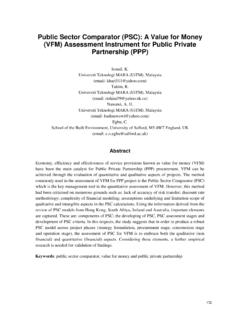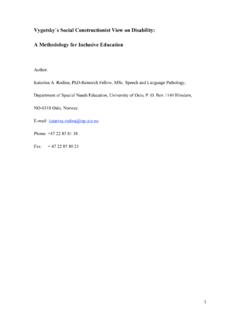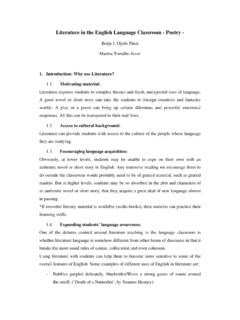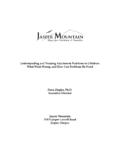Transcription of Construction€Risk€Identification - irbnet.de
1 304 construction Risk IdentificationMaytorena, E., Winch, G. M, and Kiely, for Research in the Management of Projects,Manchester Business School, The University of Manchester, M15 6PB, UKAbstractThe management of risks in projects is a growing area of concern in the construction industry. Both theidentification and analysis phases of the risk management process are considered the most important,for they can have a big impact on the accuracy of the risk assessment exercise. Currently it is assumedthat construction project managers rely largely on experience to identify projects risks . These decisions,influenced by individual perception and attitudes, are made primarily under conditions of individuals respond to risky or uncertain situations therefore requires an understanding of howindividuals intuitively assess the situation they perceive, before expressing a response.
2 The ProRIdeproject interviewed fifty-one construction project managers using Active Information Search (AIS) as adata collection method and cognitive mapping as a data-capturing tool. Our results suggest that the roleof experience in the risk identification process is much less significant than is commonly assumed tobe. By contrast, level of education and style of enquiry do play a significant role in risk identificationperformance. These findings suggest the potential for a more thorough approach to risk : project risk management, risk identification , active information search andcognitive IntroductionRisk management has become an important area of interest in the field of construction projectmanagement over the past decade.
3 Interest in the management of risk has increased ascompetition between firms, and as the size and complexity of project has grown. This has led tothe development of best practice standards, tools and techniques. Both the risk identification andrisk analysis phases of the risk management process (RMP) are generally considered the mostimportant as these can have the biggest impact on the precision of the risk assessment [1-3].While the analysis process and its tools and techniques are well developed, such analysis isdependent on risk being accurately identified in the first instance. However, compared with theanalysis phase, the process of risk identification is poorly understood and the tools andtechniques are less developed.
4 The aim of the ProRIde research funded by the UK Engineeringand Physical Sciences Research Council (award GR/N51452/01) is to provide a betterunderstanding of the project risk identification process. Thus we focus our research on the waysin which construction project managers identify risks ; our aim is to provide the basis for a morerigorous approach to the identification phase of project risk Project Risk Management: An OverviewInterest in project risk management has increased as the size and complexity of projects hasgrown and as competition between businesses intensifies. The rapidly changing context and itsinfluence on the way projects develop has made the RMP an ever more important best practice standards such asA Guide to the Project Management Body ofKnowledge(PMBoK Guide)[4],Project Risk Analysis and Management Guide(PRAM) [5],RAMP: Risk Analysis and Management for Projects guide [6] and the British StandardsInstitution guides [7; 8], as well as specialist tools and techniques have been developedfocussing on a more effective RMP.
5 These standards share a basic conception of the RMP(Figure 1). This generic model consists of four basic sub-processes located in the context ofclearly defined project objectives, which are iteratively looped through the project lifecycle:identify and classify the risks , analyse the risks , respond to the risks and monitor the is also a growing body of research on the process as a whole, with increasing advocacy ofrisk management maturity models [9].Figure 1: A generic model of the risk management sub-processes [10]The identification phase, where the question of what might happen is addressed, has been thesubject of much less research compared with the analysis phase.
6 The most recent exceptionsinclude research on the effectiveness of risk identification tools at group level [1] and theinfluences on risk identification and assessment in construction design management [11].However, risk identification remains a poorly understood process and its tools and techniquesare less developed compared to those used in the risk analysis phase [12; 13]. The focus of theliterature is on the tools and techniques used for assisting in risk identification , such as riskregisters, risk breakdown structures (RBS) and brainstorming. The widely used risk register is alist of all the risks that have been previously identified; its development is typically ad-hoc.
7 Forthis to be of practical use, the register has to be filtered for a particular project under scrutinyand the results prioritised. However, it is not clear how this is done and how reliable the resultsare [14]. There appears to be a complete lack of connection with the literature on knowledgemanagement as a tool for capturing organisational learning from projects [15]. Gaining suchunderstanding requires the systematic analysis of data for a large number of projects, but such datasets are difficult to acquire Dalton [16] reports on one attempt to fill this gap. RBS provide ahierarchical structure of potential risk sources [17] from which a list of risks can be drawn throughidentify & classifythe riskrespond to the riskmonitor the riskanalyse the riskProject mission306a brainstorming session.
8 Brainstorming [18] is project specific and requires a group of experiencedpractitioners to creatively consider possible risk sources. The list is then more analyticallyconsidered and key risks identified. The difficulties with brainstorming include the selection of theappropriate experts and their number, bringing these experts together frequently enough to be ofuse to a dynamic project lifecycle, and the avoidance of groupthink construction projects there are some standard risk areas that need to be considered andassessed, but each new project also brings specific project related risks , which need to beidentified.
9 The difficulty is the lack of accurate systems for identifying risks in a constructionproject. The studies that have been carried out over the past decade on the use of riskmanagement practices in construction and other industries [1; 2; 19-23] indicate that over thistime: checklists, brainstorming and interview sessions have been the most commonly used riskidentification tools; other techniques are rarely used due to lack of knowledge and doubts abouttheir applicability in the construction industry; there is limited progress on the wider applicationof tools and techniques; there is concern that in practice the distinction between the riskmanagement process phases is blurred and existing tools are not sufficient.
10 Research currentlyassumes that the construction industry relies heavily on historical data and the judgement of keyactors involved in the project to identify risks . For instance, Chapman [11], and Al-Tabtabai andDiekmann [24] state that the identification of risks relies on the individual judgement andinsight of the various actors involved in a project, which is dependent on their knowledge,professional training, role, level of responsibility and length of exposure to the constructionindustry. The premise of both research and practice in project risk management is thatexperience isthe key to risk ProRIde: the MethodProject risk identification is part of the more general problem of judgement under uncertainty[25].



